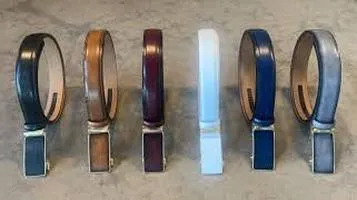Belts: A Timeless Accessory with Functional Elegance
Belts are versatile accessories primarily used to secure clothing, such as trousers or skirts, around the waist. They come in various materials, including leather, fabric, and synthetic materials, and are available in numerous styles, widths, and colors to complement different outfits and occasions. Beyond their functional purpose, belts serve as a fashion statement, adding a touch of elegance or edginess to an ensemble. Buckles, which can range from simple to ornate, often define the belt’s style, allowing for personal expression. In addition to fashion, belts are used in various fields, such as utility belts for carrying tools or gear. Overall, belts are essential accessories that blend practicality with style, enhancing both form and function in attire.

Belts, often perceived as mere tools for holding up trousers, are in reality multifaceted accessories that seamlessly blend functionality with style. Their significance transcends generations, cultures, and fashion trends, making them an indispensable component of both wardrobes and practical daily wear. This review delves into the evolution, varieties, and the enduring appeal of belts, exploring why they remain a staple in fashion and utility.
Historical Evolution
The history of belts dates back to the Bronze Age when they were primarily used by men to secure clothing and carry tools. Ancient civilizations, such as the Egyptians and Romans, also utilized belts, which were often ornate and symbolized status and power. Fast forward to the Middle Ages, belts became essential for knights, serving both practical and decorative purposes. Moving into the modern era, the Industrial Revolution heralded a shift in fashion, with belts becoming an integral part of everyday attire for both men and women.
Variety and Versatility
The sheer variety of belts available today is staggering, catering to diverse tastes, functions, and fashion sensibilities. From classic leather belts to contemporary fabric options, the market is replete with choices:
1. Leather Belts: Renowned for their durability and timeless appeal, leather belts are a quintessential accessory. They come in a range of finishes, including smooth, textured, and suede, and are often adorned with metal buckles that add a touch of sophistication. High-quality leather belts, such as those made from full-grain or top-grain leather, develop a beautiful patina over time, enhancing their charm.
2. Fabric Belts: These belts offer a more casual and versatile option. Made from materials like canvas, nylon, or woven fabrics, they are perfect for informal settings and outdoor activities. Fabric belts often feature adjustable buckles or D-rings, providing flexibility and comfort.
3. Designer Belts: For the fashion-forward, designer belts from luxury brands like Gucci, Louis Vuitton, and Hermès are coveted items. These belts often feature iconic logos, intricate designs, and premium materials, making them statement pieces that can elevate any outfit.
4. Utility Belts: Beyond fashion, utility belts serve specific functions. Tool belts for craftsmen, tactical belts for military and law enforcement personnel, and weightlifting belts for athletes are designed with practicality in mind, offering specialized features to meet the needs of various professions and activities.
Functional Elegance
A belt's primary function is to hold up trousers, but its role extends far beyond mere utility. Belts can define the waistline, add a pop of color or texture, and even serve as focal points in an ensemble. They have the power to transform an outfit, making a simple pair of jeans and a t-shirt look polished and put-together.
In professional settings, a well-chosen belt can convey a sense of attention to detail and personal style. For instance, pairing a sleek black leather belt with a tailored suit exudes sophistication and confidence. Conversely, a casual fabric belt paired with chinos and a polo shirt creates a relaxed, yet stylish look perfect for weekend outings.
Cultural Significance
Belts also carry cultural and symbolic meanings. In some societies, belts are integral to traditional attire. For example, the obi in Japanese kimono culture, the cummerbund in Indian formal wear, and the sash belts in various indigenous garments all hold cultural significance and are often used in ceremonial contexts. These belts are not just accessories but are imbued with history, tradition, and identity.
Sustainability and Innovation
As the fashion industry increasingly prioritizes sustainability, belts are no exception. Eco-conscious consumers are driving demand for belts made from sustainable materials like recycled fabrics, vegan leather, and natural fibers. Brands are responding by innovating with eco-friendly production processes and materials, ensuring that style does not come at the expense of the planet.
Challenges and Considerations
While belts are versatile and stylish, there are considerations to keep in mind. The quality of materials and craftsmanship can vary widely, impacting durability and appearance. It's essential to invest in well-made belts to ensure longevity and satisfaction. Additionally, understanding the appropriate belt width and style for different occasions and outfits is crucial for achieving the desired look.
Conclusion
Belts are far more than functional accessories; they are emblematic of personal style, cultural heritage, and evolving fashion trends. Their ability to marry practicality with elegance ensures their continued relevance in wardrobes around the world. Whether you opt for a classic leather belt, a casual fabric one, or a luxurious designer piece, the right belt can enhance your outfit and express your individuality. As fashion continues to evolve, belts will undoubtedly remain a timeless and indispensable accessory, balancing utility and style with effortless grace.






